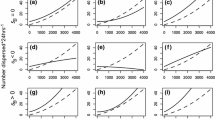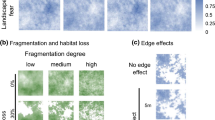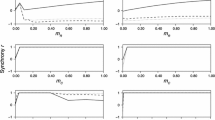Abstract
Predation can both reduce prey abundance directly (through density-dependent effects) and indirectly through prey trait-mediated effects. Over the years, many studies have focused on describing the density-area relationship (DAR). However, the mechanisms responsible for the DAR are not well understood. Loss and fragmentation of habitats, owing to human activities, creates landscape-level spatial heterogeneity wherein patches of varying size, isolation and quality are separated by a human-modified “matrix” of varying degrees of hostility and has been a primary driver of species extinctions and declining biodiversity. How matrix hostility in combination with trait-mediated effects influence DAR, minimum patch size, and species coexistence remains an open question. In this paper, we employ a theoretical spatially explicit predator–prey population model built upon the reaction-diffusion framework to explore effects of predator-induced emigration (trait-mediated emigration) and matrix hostility on DAR, minimum patch size, and species coexistence. Our results show that when trait-mediated response strength is sufficiently strong, ranges of patch size emerge where a nonlinear hump-shaped prey DAR is predicted and other ranges where coexistence is not possible. In a conservation perspective, DAR is crucial not only in deciding whether we should have one large habitat patch or several-small (SLOSS), but for understanding the minimum patch size that can support a viable population. Our study lends more credence to the possibility that predators can alter prey DAR through predator-induced prey dispersal.












Similar content being viewed by others
Availability of data and materials
Not applicable.
References
Acharya A, Bandyopadhyay S, Cronin JT, Goddard J, Muthunayake A, Shivaji R (2023) The diffusive Lotka–Volterra competition model in fragmented patches i: Coexistence. Nonlinear Anal Real World Appl 70:103775. https://doi.org/10.1016/j.nonrwa.2022.103775
Amann H (1976) Nonlinear elliptic equations with nonlinear boundary conditions. North-Holland, Amsterdam, , vol 21, pp 43–63. https://doi.org/10.1016/S0304-0208(08)71154-X
Bender DJ, Contreras TA, Fahrig L (1998) Habitat loss and population decline: a meta-analysis of the patch size effect. Ecology 79(2):517–533. https://doi.org/10.1890/0012-9658(1998)079[0517:HLAPDA]2.0.CO;2
Bowers MA, Matter SF (1997) Landscape ecology of mammals: relationships between density and patch size. J Mammal 78(4):999–1013. https://doi.org/10.2307/1383044
Buckley LB, Roughgarden J (2006) A hump-shaped density-area relationship for island lizards. Oikos 113(2):243–250. https://doi.org/10.1111/j.2006.0030-1299.14401.x
Cantrell RS, Cosner C (2003) Spatial ecology via reaction-diffusion equations. Mathematical and Computational Biology. Wiley, Chichester, p 411
Cantrell RS, Cosner C (2006) On the effects of nonlinear boundary conditions in diffusive logistic equations on bounded domains. J Differ Equ 231:768–804
Cantrell RS, Cosner C (2007) Density dependent behavior at habitat boundaries and the Allee effect. Bull Math Biol 69:2339–2360. https://doi.org/10.1007/s11538-007-9222-0
Cantrell RS, Cosner C (2018) Effects of harvesting mediated by dispersal traits. Nat Resour Model 31(4):12168. https://doi.org/10.1111/nrm.12168
Cantrell RS, Cosner C, Fagan WF (1998) Competitive reversals inside ecological reserves: the role of external habitat degradation. J Math Biol 37(6):491–533. https://doi.org/10.1007/s002850050139
Cantrell R, Cosner C, Lou Y (2004) Multiple reversals of competitive dominance in ecological reserves via external habitat degradation. J Dyn Differ Equ 16(4):973–1010. https://doi.org/10.1007/s10884-004-7831-y
Connor EF, Courtney AC, Yoder JM (2000) Individuals-area relationships: the relationship between animal population density and area. Ecology 81(3):734–748. https://doi.org/10.1890/0012-9658(2000)081[0734:IARTRB]2.0.CO;2
Cronin JT (2007) Shared parasitoids in a metacommunity: indirect interactions inhibit herbivore membership in local communities. Ecology 88(12):2977–2990. https://doi.org/10.1890/07-0253.1
Cronin JT, Haynes KJ, Dillemuth F (2004) Spider effects on planthopper mortality, dispersal, and spatial population dynamics. Ecology 85(8):2134–2143. https://doi.org/10.1890/03-0591
Cronin JT, Goddard J II, Shivaji R (2019) Effects of patch matrix-composition and individual movement response on population persistence at the patch-level. Bull Math Biol 81(10):3933–3975. https://doi.org/10.1007/s11538-019-00634-9
Cronin JT, Fonseka N, Goddard J II, Leonard J, Shivaji R (2019) Modeling the effects of density dependent emigration, weak Allee effects, and matrix hostility on patch-level population persistence. Math Biosci Eng 17(2):1718–1742
Cronin JT, Goddard J II, Muthunayake A, Shivaji R (2020) Modeling the effects of trait-mediated dispersal on coexistence of mutualists. Math Biosci Eng 17(6):7838–7861. https://doi.org/10.3934/mbe.2020399
Debinski DM, Holt RD (2000) A survey and overview of habitat fragmentation experiments. Conserv Biol 14(2):342–355. https://doi.org/10.1046/j.1523-1739.2000.98081.x
Ewers RM, Didham RK, Pearse WD, Lefebvre V, Rosa IMD, Carreiras JMB, Lucas RM, Reuman DC (2013) Using landscape history to predict biodiversity patterns in fragmented landscapes. Ecol Lett 16(10):1221–1233. https://doi.org/10.1111/ele.12160
Fonseka N, Goddard J II, Morris Q, Shivaji R, Son B (2020a) On the effects of the exterior matrix hostility and a u-shaped density dependent dispersal on a diffusive logistic growth model. Topol Methods Nonlinear Anal 13(12):1–15
Fonseka N, Goddard J II, Shivaji R, Son B (2020b) A diffusive weak allee effect model with u-shaped emigration and matrix hostility. Discrete Contin Dyn Syst Ser B 26(10):5509–5517. https://doi.org/10.3934/dcdsb.2020356
Goddard II J, Shivaji R (2017) Stability analysis for positive solutions for classes of semilinear elliptic boundary-value problems with nonlinear boundary conditions. Proc R Soc Edinb 147(A):1019–1040
Goddard J II, Morris Q, Robinson S, Shivaji R (2018) An exact bifurcation diagram for a reaction diffusion equation arising in population dynamics. Boundary Value Problems 170:1–17. https://doi.org/10.1186/s13661-018-1090-z
Goddard J II, Morris Q, Payne C, Shivaji R (2019) A diffusive logistic equation with u-shaped density dependent dispersal on the boundary. Topol Methods Nonlinear Anal 53(1):335–349
Goddard J II, Shivaji R, Cronin JT (2023) Ecological release and patch geometry can cause nonlinear density–area relationships. J Theor Biol 557(21):1–14
Hakkarainen H, Ilmonen P, Koivunen V, Korpimäki E (2001) Experimental increase of predation risk induces breeding dispersal of Tengmalm’s owl. Oecologia 126(3):355–359. https://doi.org/10.1007/s004420000525
Hambäck PA, Englund G (2005) Patch area, population density and the scaling of migration rates: the resource concentration hypothesis revisited. Ecol Lett 8(10):1057–1065. https://doi.org/10.1111/j.1461-0248.2005.00811.x
Hanski I (1999) Metapopulation ecology. Oxford University Press
Harman R, Goddard J II, Shivaji R, Cronin JT (2020) Frequency of occurrence and population-dynamic consequences of different forms of density-dependent emigration. Am Nat 195(5):851–867
Haynes KJ, Cronin JT (2003) Matrix composition affects the spatial ecology of a prairie planthopper. Ecology 84(11):2856–2866. https://doi.org/10.1890/02-0611
Heilman GE, Strittholt JR, Slosser NC, Dellasala DA (2002) Forest fragmentation of the conterminous United States: assessing forest intactness through road density and spatial characteristics: Forest fragmentation can be measured and monitored in a powerful new way by combining remote sensing, geographic information systems, and analytical software. Bioscience 52(5):411–422. https://doi.org/10.1641/0006-3568(2002)052[0411:FFOTCU]2.0.CO;2
Holt RD, Barfield M (2012) Trait-mediated effects, density dependence and the dynamic stability of ecological systems. Cambridge University Press, Cambridge, New York
Irwin RE (2012) The role of trait-mediated indirect interactions for multispecies plant-animal mutualisms. Cambridge University Press, Cambridge, New York, pp 257–277
Jackson HB, Zeccarias A, Cronin JT (2013) Mechanisms driving the density-area relationship in a saproxylic beetle. Oecologia 173(4):1237–1247. https://doi.org/10.1007/s00442-013-2697-5
Jonsson M, Wratten SD, Landis DA, Gurr GM (2008) Recent advances in conservation biological control of arthropods by arthropods. Biol Control 45(2):172–175. https://doi.org/10.1016/j.biocontrol.2008.01.006
Landis DA, Wratten SD, Gurr GM (2000) Habitat management to conserve natural enemies of arthropod pests in agriculture. Annu Rev Entomol 45(1):175–201. https://doi.org/10.1146/annurev.ento.45.1.175
Laundré JW, Hernández L, Medina PL, Campanella A, López-Portillo J, González-Romero A, Grajales-Tam KM, Burke AM, Gronemeyer P, Browning DM (2014) The landscape of fear: the missing link to understand top-down and bottom-up controls of prey abundance? Ecology 95(5):1141–1152. https://doi.org/10.1890/13-1083.1
Laundré JW, Hernández L, Altendorf KB (2001) Wolves, elk, and bison: reestablishing the “landscape of fear” in Yellowstone National Park, USA. Can J Zool 79(8):1401–1409. https://doi.org/10.1139/z01-094
Lindenmayer DB, Wood J, McBurney L, Blair D, Banks SC (2015) Single large versus several small: the Sloss debate in the context of bird responses to a variable retention logging experiment. For Ecol Manage 339:1–10. https://doi.org/10.1016/j.foreco.2014.11.027
MacArthur RH (1972) Geographical ecology: patterns in the distribution of species. Princeton University Press
Maciel GA, Lutscher F, Associate Editor: Sean HR, Editor: Troy D (2013) How individual movement response to habitat edges affects population persistence and spatial spread. Am Naturalist 182(1):42–52. https://doi.org/10.1086/670661
Matassa CM, Trussell GC (2011) Landscape of fear influences the relative importance of consumptive and nonconsumptive predator effects. Ecology 92(12):2258–2266. https://doi.org/10.1890/11-0424.1
Matter SF (1999) Population density and area: the role of within- and between-generation processes over time. Ecol Model 118(2):261–275. https://doi.org/10.1016/S0304-3800(99)00051-4
Matter SF (2000) The importance of the relationship between population density and habitat area. Oikos 89(3):613–619
Mccarthy MA, Thompson CJ, Possingham HP (2005) Theory for designing nature reserves for single species. Am Nat 165(2):250–257
McCoy ED, Mushinsky HR (2007) Estimates of minimum patch size depend on the method of estimation and the condition of the habitat. Ecology 88(6):1401–1407. https://doi.org/10.1890/06-1188
Ohgushi T, Schmitz O, Holt RD (2012) Trait-mediated indirect interactions: ecological and evolutionary perspectives. Cambridge University Press, New York
Oswald J (1998) Schmitz: Direct and indirect effects of predation and predation risk in old-field interaction webs. Am Nat 151(4):327–342. https://doi.org/10.1086/286122
Ovaskainen O (2004) Habitat-specific movement parameters estimated using mark-recapture data and a diffusion model. Ecology 85(1):242–257. https://doi.org/10.1890/02-0706
Ovaskainen O, Cornell SJ (2003) Biased movement at a boundary and conditional occupancy times for diffusion processes. J Appl Probab 40(3):557–580. https://doi.org/10.2307/3215936
Pao CV (1992) Nonlinear parabolic and elliptic equations. Plenum Press, New York, p 777
Peckarsky BL (1996) Alternative predator avoidance syndromes of stream-dwelling mayfly larvae. Ecology 77(6):1888–1905. https://doi.org/10.2307/2265793
Sand H, Jamieson M, Andrén H, Wikenros C, Cromsigt J, Månsson J (2021) Behavioral effects of wolf presence on moose habitat selection: testing the landscape of fear hypothesis in an anthropogenic landscape. Oecologia 197(1):101–116. https://doi.org/10.1007/s00442-021-04984-x
Schmitz OJ (2003) Top predator control of plant biodiversity and productivity in an old-field ecosystem. Ecol Lett 6(2):156–163. https://doi.org/10.1046/j.1461-0248.2003.00412.x
Sih A, Kats LB, Moore RD (1992) Effects of predatory sunfish on the density, drift, and refuge use of stream salamander larvae. Ecology 73(4):1418–1430. https://doi.org/10.2307/1940687
Simberloff D, Abele LG (1982) Refuge design and island biogeographic theory: effects of fragmentation. Am Nat 120(1):41–50. https://doi.org/10.1086/283968
Uchida K, Ushimaru A (2014) Biodiversity declines due to abandonment and intensification of agricultural lands: patterns and mechanisms. Ecol Monogr 84(4):637–658. https://doi.org/10.1890/13-2170.1
Werner EE, Peacor SD (2003) A review of trait-mediated indirect interactions in ecological communities. Ecology 84(5):1083–1100. https://doi.org/10.1890/0012-9658(2003)084[1083:arotii]2.0.co;2
Wright SJ (1981) Extinction-mediated competition: the Anolis lizards and insectivorous birds of the West Indies. Am Nat 117(2):181–192. https://doi.org/10.1086/283697
Wright SJ, Kimsey R, Campbell CJ (1984) Mortality rates of insular Anolis lizards: A systematic effect of island area? Am Nat 123(1):134–142. https://doi.org/10.1086/284192
Acknowledgements
This material is based upon work supported by the National Science Foundation under Grant Nos. DMS-1853359, DMS-1853372, DMS-1853352, DMS-2150945, DMS-2150946, & DMS-2150947.
Author information
Authors and Affiliations
Contributions
All authors contributed to the study conception and design, analysis, and writing/revising of the manuscript. If any of the sections are not relevant to your manuscript, please include the heading and write ‘Not applicable’ for that section.
Corresponding author
Ethics declarations
Conflict of interest
The authors have no competing interests to declare that are relevant to the content of this article.
Additional information
Publisher's Note
Springer Nature remains neutral with regard to jurisdictional claims in published maps and institutional affiliations.
Rights and permissions
Springer Nature or its licensor (e.g. a society or other partner) holds exclusive rights to this article under a publishing agreement with the author(s) or other rightsholder(s); author self-archiving of the accepted manuscript version of this article is solely governed by the terms of such publishing agreement and applicable law.
About this article
Cite this article
Cronin, J.T., Goddard II, J., Muthunayake, A. et al. Predator-induced prey dispersal can cause hump-shaped density-area relationships in prey populations. J. Math. Biol. 88, 20 (2024). https://doi.org/10.1007/s00285-023-02040-1
Received:
Revised:
Accepted:
Published:
DOI: https://doi.org/10.1007/s00285-023-02040-1
Keywords
- Predator-induced emigration
- Trait-mediated emigration
- Density–area relationship
- Reaction diffusion model
- Ecological release
- Dispersal release




